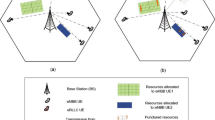Abstract
To achieve high capacity in cellular networks, frequency reuse factor of unity is used. However, it suffers from heavy co-channel interference at cell edge regions. This leads to poor Signal to Interference plus Noise Ratio (SINR) and hence poor performance. fractional frequency reuse (FFR) is one of the methods being considered to improve cell edge performance. In this work we present the impact of SINR threshold and bandwidth partitioning on the successful deployment of FFR scheme. We have considered both real time (RT) and best effort (BE) traffic. In FFR, the total frequency resource is divided logically into cell center and cell edge user bands. However, while frequency resource is partitioned into two segments, the amount of bandwidth required by cell center and cell edge users is quite different and influences the system performance. We developed the semi analytical approach to evaluate the average bandwidth required by cell center and edge band users. From the analysis and simulation results it is seen that while grade of service (GoS) fair based method of choosing bandwidth partitioning ratio is best for RT traffic, while the only feasible method for BE traffic is dividing the bandwidth based on probability of a user to be in a given band which we termed as ‘Probability’ method.










Similar content being viewed by others
References
Korowajczuk, L. (2011). LTE, WiMAX and WLAN network design, optimization and performance analysis. UK: Wiley.
M2135 (2008). Guidelines for evaluation of radio interface technologies for IMT-advanced. ITU, Technical Report.
Boudreau, G., Panicker, J., Guo, N., Chang, R., Wang, N., & Vrzic, S. (2009). Interference coordination and cancellation for 4G networks. IEEE Communications Magazine, 47(4), 74–81.
Xiang, Y., Luo, J., & Hartman, C. (2007). Inter-cell interference mitigation through flexible resource reuse in OFDMA based communication networks. In 13th IEEE European wireless conference, (pp. 1–7).
Lei, H., & Zhang, X. (2007). A novel frequency reuse scheme for multi-cell OFDMA systems. In IEEE vehicular technology conference—fall proceedings (pp. 347–351).
Elayoubi, S.-E., Ben Haddada, O., & Fourestie, B. (2008). Performance evaluation of frequency planning schemes in OFDMA based networks. IEEE Transactions on Wireless Communications, 7(5), 1623–1633.
Qian, M., Hardjawana, W., Li, Y., Vucetic, B., Shi, J., & Yang, X. (2012). Inter-cell interference coordination through adaptive soft frequency reuse in LTE networks. In IEEE Wireless communications and networking conference (pp. 1618–1623).
Chiu, C.-S., & Huang, C.-C. (2009). A hybrid inter-cell interference mitigation scheme for an OFDMA downlink system. IEICE Transactions on, Communication, E93-B(1), 73–81
Xu, Z., Li, G., & Yang, C. (2011). Optimal threshold design for FFR schemes in multi-cell OFDMA networks. In IEEE international conference on communications (pp. 1–5).
Novlan, T., Ganti, R., Ghosh, A., & Andrews, J. (2011). Analytical evaluation of fractional frequency reuse for OFDMA cellular networks. IEEE Transactions on Wireless Communications, 10(12), 4294–4305.
Stuber, G. L. (1996). Principles of mobile communications. Piscataway, NJ, USA: Kluwer Academic.
Molisch, A. F., Mehta, N. B., Wu, J., & Zhang, J. (2007). Approximating a sum of random variables with a log normal. IEEE Transactions on Wireless Communications, 6(7), 2690–2699.
Turkmani, A. M. D. (1992). Probability of error for m-branch macroscopic selection diversity. IEEE Proceedings in Communication Speech Vision, 139, 71–78.
Mogensen, P. et al. (2007). LTE capacity compared to Shannon bound. In IEEE 65th vehicular technology conference—fall proceedings (pp. 1234–1238).
Batabyal, S., & Das, S. (2012). Distance dependent call blocking probability, and area Erlang efficiency of cellular networks. In IEEE 75th vehicular technology conference—spring (pp. 1–5).
Das, S. S., Ghosh, P., & Chandhar, P. (2012). Estimation of effective radio resource usage for VoIP scheduling in OFDMA cellular networks. In IEEE 75th vehicular technology conference, spring (pp. 1–6).
Guerin, R., et al. (1991). Equivalent capacity and its application to bandwidth allocation in high-speed networks. IEEE Journal on Selected Areas on Communications, 9(7), 968–981.
Ghosh, P., Das, S. S., & Chandhar, P. (2012). VoIP scheduling with reduced overhead and radio resource usage estimation-effect on best effort capacity. In IEEE national conference on communications (pp. 1–5).
Karray, M. (2010). Analytical evaluation of QoS in the downlink of OFDMA wireless cellular networks serving streaming and elastic traffic. IEEE Transactions on Wireless Communications, 9(5), 1799–1807.
Kaufman, J. S. (1981). Blocking in a shared resource environment. IEEE Transactions on Communications, 29(10), 1474–1481.
Author information
Authors and Affiliations
Corresponding author
Rights and permissions
About this article
Cite this article
Boddu, S.R., Mukhopadhyay, A., Philip, B.V. et al. Bandwidth Partitioning and SINR Threshold Analysis of Fractional Frequency Reuse in OFDMA Cellular Networks for Real Time and Best Effort Traffic. Wireless Pers Commun 75, 325–347 (2014). https://doi.org/10.1007/s11277-013-1365-8
Published:
Issue Date:
DOI: https://doi.org/10.1007/s11277-013-1365-8




